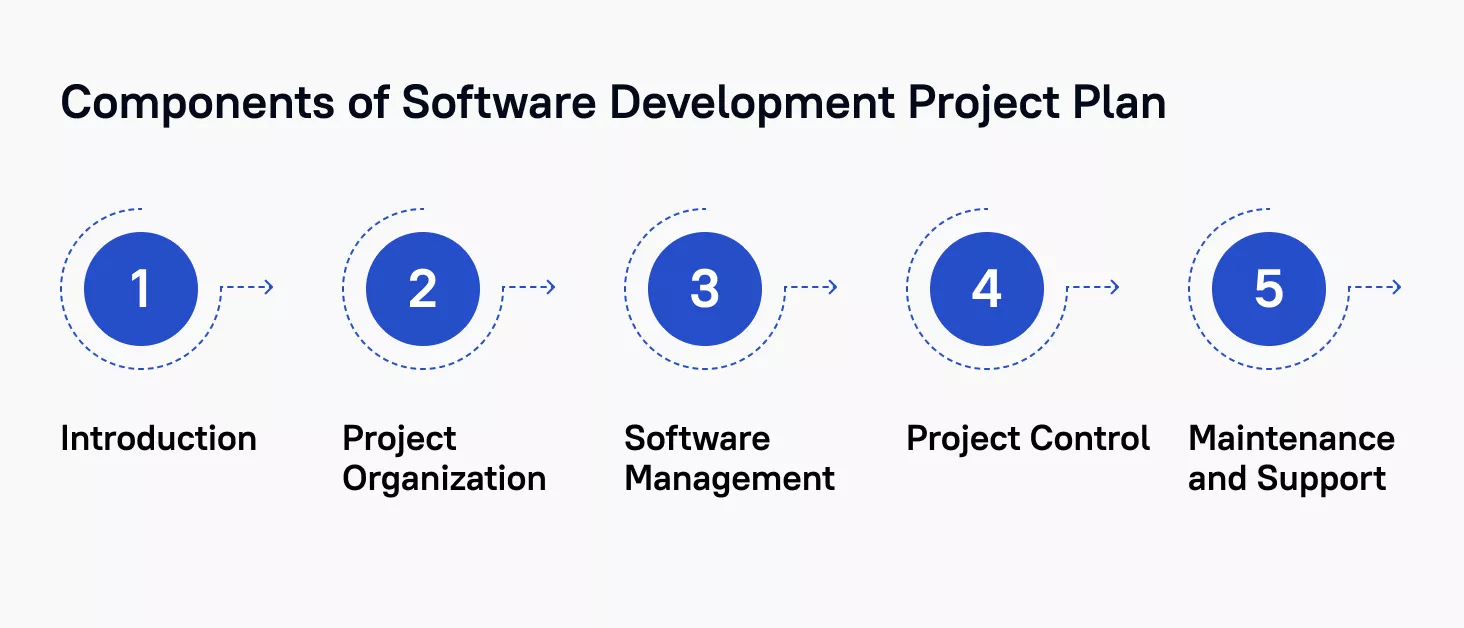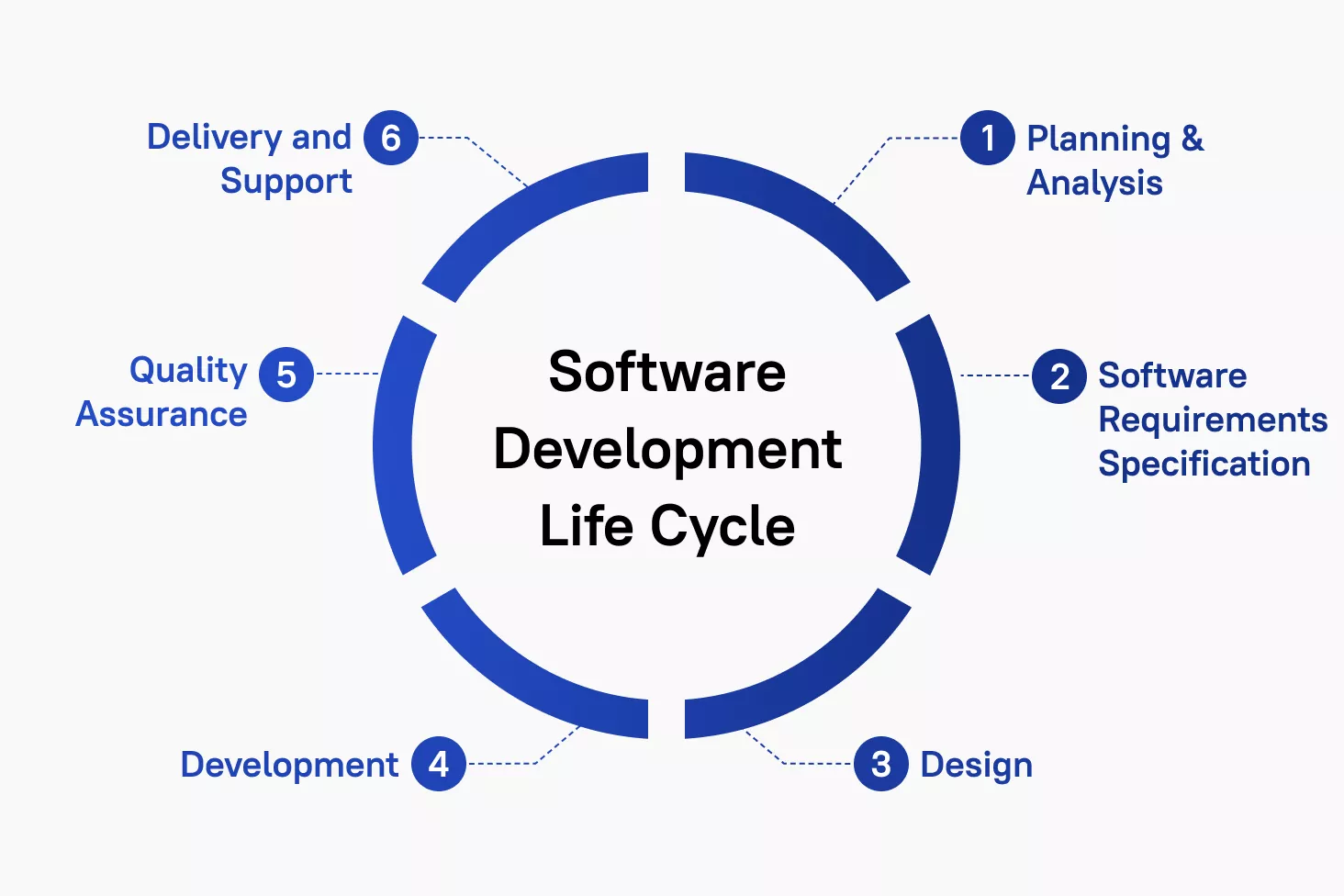
Today we will talk about how high-quality programs are created, or rather, how to write a software development plan. If you want to create cool applications, then you should follow all these steps or at least most of them.
What is a Software Development Plan?
The SDP or Software Development Plan is a composite document containing all the information needed to manage a project. The information is either directly included in the content of the SDP, or links to other specifications and plans are placed there.
The project plan for software implementation describes the reason a developer is involved in a project and how they intend to build it. It also includes developing methods and gives team members a framework for monitoring the project while they work on it. Some of the factors the SDP aims to address include
- Problems that the program will solve
- Development approach that the team will use
- Key Features of the Software
- Development order
- Leadership roles in the project
- Responsibilities of each team member
Why you Need a Software Development Plan
There are several key elements in planning the development process. Let's take a quick look at three factors in terms of software development:
1. Management of risks
When it comes to software development, there is a chance that things will not go the way you would like them to. This is where risk management comes into play. You identify risks, prioritize them, and make a plan to mitigate them.
2. Resource allocation
You must carefully allocate sufficient resources to the various stages of development. Proper allocation of resources will ensure the smooth implementation of the project. This means that you must estimate the total time, effort, and resource consumption and allocate resources accordingly. Improper allocation of resources can lead to unusual delays in project implementation and missed deadlines.
3. Documentation
Creating instructions and information to help users interact with the software is extremely important. But that's not all. You will also have agreements regarding software maintenance and updates. This will help you set clear expectations and avoid conflicts related to post-development maintenance of the software.
Purpose and Objective of a Software Development Plan
The goal of the SW development projects plan is to communicate to team members and stakeholders the method to be chosen when developing software and how a Program Manager will use direct resources.
The objective of the SDP is to include a framework with a clear understanding of developing software and the issues they are trying to solve. An example of questions:
- What problems are being solved?
- What are the main tasks of development?
- What software development method will be used?
- What are the key functions?
- What is the schedule of development?
- What is the order of development?
- What are the team's responsibilities?
- How is quality control implemented and measured?
Want a web app that does more?
Let's build a solution that's smart, sleek, and powerful.
Alina
Client Manager

7 Steps of Software Development Planning Process
Software development is a hard technical process that requires a lot of steps. When you have a project plan it becomes easier to follow each step of its development
Set Your Goals
When you define the goals and scope of your project it will help to indicate your ideal endpoint and clarifies the purpose of the project. You have to define and outline your goals which will make it easier to set up a plan.
Define Your Project Workflow
Once you define your goals, you can define workflow and what you need to reach endpoints. Requirements will include - the team, equipment, time, skills, and budget. These requirements will change depending on your specific goals.
Forming a budget
Budget is a crucial part of planning a software development project. You have to develop a list of requirements to determine a rough cost estimate.
Documentation and requirements
When the goals are defined, teams can see what they need to achieve the desired result. The needed resources include the following aspects:
- Resources
- Budget
- Time
Each aspect of the software planning document is vital to accomplish. The resources depend on the idea and size of the project. The availability of the resources is included in the documentation. It will help developers understand the needs and goals of the software development process. It includes the scale of the project and initial requirements and objectives. Your development team and you have to document the technical requirements for successfully delivering the software product.
Create a Timeline
When you have outlined the basic elements of your software development plan, it’s time to create a software development schedule. You can break down the tasks and look at the resources such as budget and team, so you can build a rough estimate of the time it will take to complete the project. It's important to include extra time to complete all your tasks or have a project manager on board to ensure your project meets deadlines.
Build a Team
When goals, budgets, timelines, and other plans are set, it's time to build a team. This is not an easy task, and it can take time to find the right developers. One option is hiring a team of developers from a web development company, it will save time and costs.
Progress and Quality
It's crucial to provide quality testing and progress checkouts as a part of your plan. Quality testing is a very important part of software development as a final step.
Key Components of Software Development Project Plan
There is no software development planning template that all SDPs must follow, but there are crucial parts that must be included.

Introduction
This part is pretty obvious. You must provide the purpose behind the plan and the goals you are trying to achieve with it. The introduction must include
- Purpose
- scope
- definitions
- acronyms
- abbreviations
- references
- overview
Project organization
This part is crucial in developing the project plan for defining project structure, communication between team members, and the general project flow.
Software Management
It is one of the most difficult aspects of the plan in the initial stages of development. Here you define what you will do for managing risks, budgeting, timelines, etc.
Project control
Here you summarize all aspects of the project that was undertaken during the development. You have to list UI/UX requirements, software requirements specifications (SRS), and business needs.
Maintenance and support
Software maintenance provides scheduled activities to solve not urgent problems or perform planned improvements. Software support covers activities on resolving urgent problems that can break software operations and cause downtimes. You need to opt for both types to ensure the high performance, stability, and security of software.
Risks to Avoid While Creating a Software Development Plan
Writing a perfect software development plan is not an easy task. The planning becomes more challenging when the project is complex.
Sudden Schedule Changes
Sometimes, SDP has tight deadlines. In some cases, software development teams couldn't meet these deadlines.
How to avoid it?
You can minimize this risk by creating a project plan that allows setting realistic deadlines.
Inaccurate Budget Estimation
Another risk of SDP is inaccurate estimations that lead to false expectations. Inaccurate estimations of costs, deadlines, and outcomes will fail to meet the customers' expectations.
How to avoid it?
You can minimize that risk by clarifying your estimations. This will help stakeholders form a realistic look at your project.
Low productivity
Software development teams may struggle with productivity issues, which can happen because of employee burnout, delays, and other factors.
How to avoid it?
You can increase your team members' productivity by:
- building a clear project plan to avoid burnout
- communicating effectively about project details and issues
- a great team leader who can motivate
- boosting productivity by setting solid goals
Communication Gaps
Another issue that could harm project communication gaps between team members.
How to avoid it?
You can minimize the risk of misunderstanding by hiring a competent team leader and building a coherent software development plan.
Loss of a Team Member
When key team members leave projects, it is a significant risk in software development. It can be hard to replace them, with skills, expertise, and project background.
How to avoid it?
You can minimize this risk by:
- Keeping documentation of the details of your project
- Building a training program for new members
- Asking an employee who is leaving to prepare a plan with the algorithm of actions
The Software Development Life Cycle

The creation and development of any product occur gradually, passing through several mandatory stages, some of which can go in parallel.
The life cycle of a project in IT is a continuous process that ends only when it is decided to close it. If you've come up with a product idea and approached the development team, brace yourself, there's a lot of work ahead.
Assessment and Planning
This is perhaps the most responsible and important of all the steps to creating a successful software system, where discovery phase service for software development plays a foundational role. All gathered information is used for planning the project approach.
Additionally, there is planning for quality assurance requirements and the identification of various risks associated with the project. The result of the analysis is the identification of various technical approaches that can be used to successfully implement the project with minimal risks. Plan what you can control and be aware of things you cannot plan. This will help you get a solid foundation to move on to the second stage.
Software Requirements Specification
Once the basic requirements analysis has been completed, the next step is to clearly define and document the requirements for the product, and approval by the customer. If one of the goals of the first stage is to understand and analyze the requirements, then at this stage all the goals should be spelled out, this is the protection of both parties.
You have to clearly define and write down what should be done, with the help of the SRS (Software Requirement Specification). The document contains all the product requirements that must be designed and developed during the life cycle of the project.
Design
SRS is a guideline for developers to suggest the best architecture for a product. There are usually several approaches to product architecture design. All proposed approaches are documented in the DDS (Design Document Specification) and the best design approach is selected. This approach very clearly defines all the architectural modules of the product, as well as its relationship with external and third-party modules.
Development
Here product development and assembly begin. All program code, new modules, and features are developed based on DDS. Perfect documentation will help the better implementation. In this phase, the development team is involved. The written code must be covered by unit tests. Then you test new features with other modules using integration tests. These activities are performed by the development team.
Quality Assurance
Quality Assurance includes all stages of the life cycle. Product defects are logged, tracked, corrected, and retested. This happens until the product reaches the quality standards that are prescribed in the SRS. At this stage, a team of manual testers is involved in the development process.
Delivery and Support
Once a product has been tested, it is released. Sometimes the implementation occurs in stages, following the business strategy. The product can first be released in a limited segment and tested in a real business environment, this is UAT testing (User Acceptance Testing). Then, based on feedback, the product can be released as is, or with suggested improvements. After the product is released to the market, its maintenance is carried out for the existing customer base, and support teams are connected at this stage.
Best Practices for Creating a Software Development Plan
The task of software development is to fulfill the requirements of the product. If you want to learn how to build and release high-quality software, you need to follow a plan.
Break the Process Down into Modules
Building an entire software plan at once is an impossible task. You have to break down the process into subtasks. You should use a module system: define each section of the plan as a module and responsible team members. Set a realistic deadline for each module and make sure that all teams are acknowledged of their work scope.
Shear of Research in Real-time
Research is a crucial process when creating a software development plan. The results of market research, user feedback, and focus groups should be available to all team members in real time with its updates.
Update the Plan
A planning software project is a continuous process. The priorities are constantly evolving. Software development must be relevant, so the team members need to revisit it regularly. Keep the previous versions in case there’s a dispute on the project.
Run a Pilot Test to Get Users' Feedback
After the feature is developed, you should test it on users. The outcome has to be reflected in an SDP. Interactions with users can change the focus from one developmental approach to another or acquire new resources. All these shifts must be documented in the project planning of software development.
Conclusion
The development of any program, whether a small procedure for processing information received on the console or a complex software product, consists of several stages, and the competent implementation of the project plan for software development is crucial for obtaining a good result. Writing a plan for a project at once is hard, so you should divide it into subtasks, and appoint a responsible for each stage of SDP.
Strict adherence to software development milestones is becoming a fundamental criterion for software companies and their customers. If you are interested in getting a program that performs its functions perfectly, contact us.



